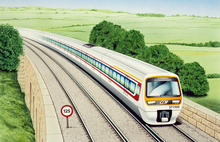British Rail Classes 371, 381 and 471
| British Rail Classes 371, 381 and 471 Networker |
|
|---|---|

Artist's impression of Class 371
|
|
| Family name | Networker |
| Number built | Never Built |
| Operator(s) | British Rail (intended) |
| Line(s) served | Intended - Thameslink; Kent Coast; LTS; Great Northern |
Class 371, Class 381 and Class 471 were proposed electric multiple unit classes from the Networker family of trains intended to operate services in the south-east of England.
Classes 371 and 381 were intended as the so-called "Universal Networker", a dual voltage train capable of operating using both 25 kV AC from overhead wire and 750 V DC from third rail. It was planned that Class 371 would be used on the enhanced Thameslink 2000 services while Class 381 would be utilised on various long-distance routes across the Network SouthEast sector, including Kent Coast services from Victoria and Charing Cross, Great Northern services from Kings Cross and LTS services from Fenchurch Street. In the event, British Rail's financial limitations led to the proposal being cancelled.
Class 471 was the proposed "Main Line Networker" intended for long distance services on the Kent Coast routes of Network SouthEast. Intended as four car units, the Class 471 was to have featured an end gangway to allow passage between two connected units, with seating in 2+2 and 2+3 arrangements. First class seating was to be in side corridor compartments, but the seats (3 across with small table/bin between them) were to be no wider than standard class. The mock-up unveiled in August 1991 bore a resemblance to the Class 442 "Wessex Express" units operating to the South-West, but featured sliding doors. The Class 471 project stalled due to British Rail's limited finances; entry into service was due by 1993, and by 1992 there had still been no major work done, blamed on a lack of government investment.
...
Wikipedia
